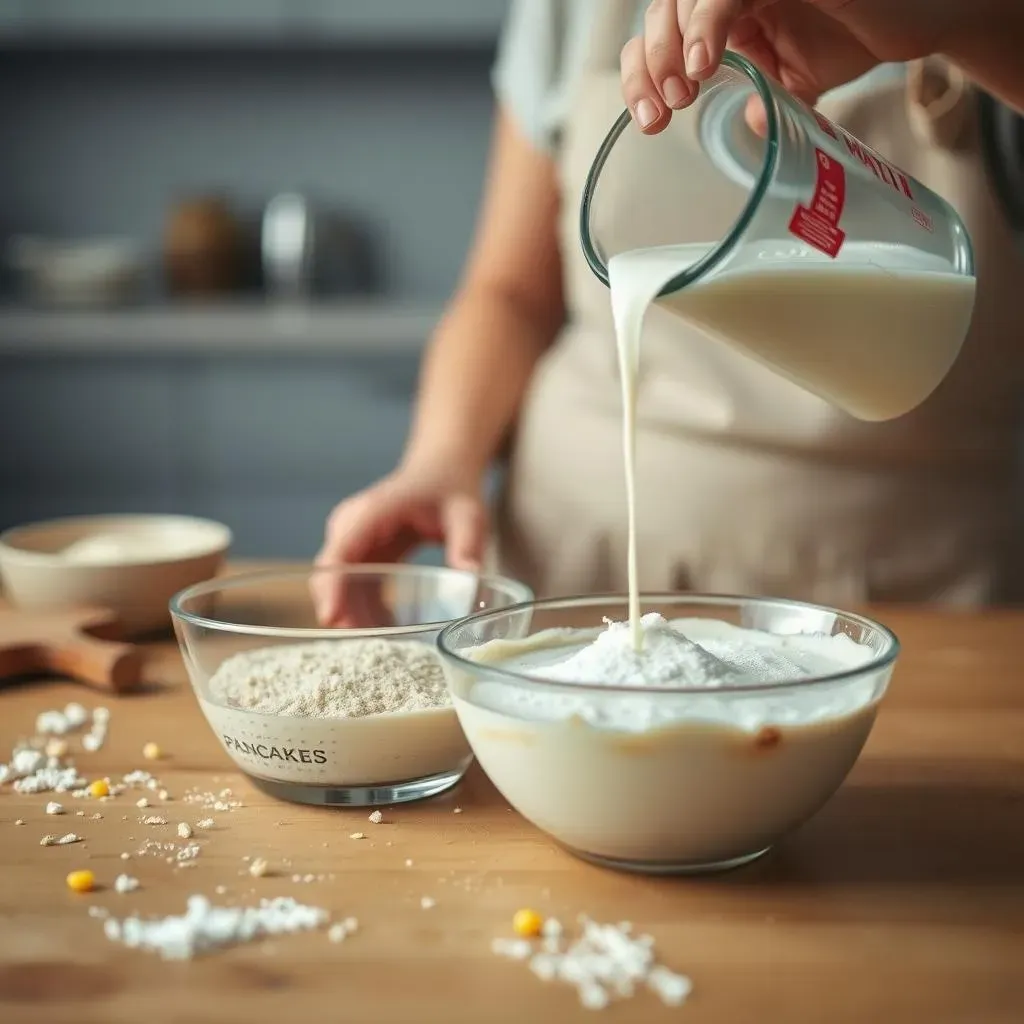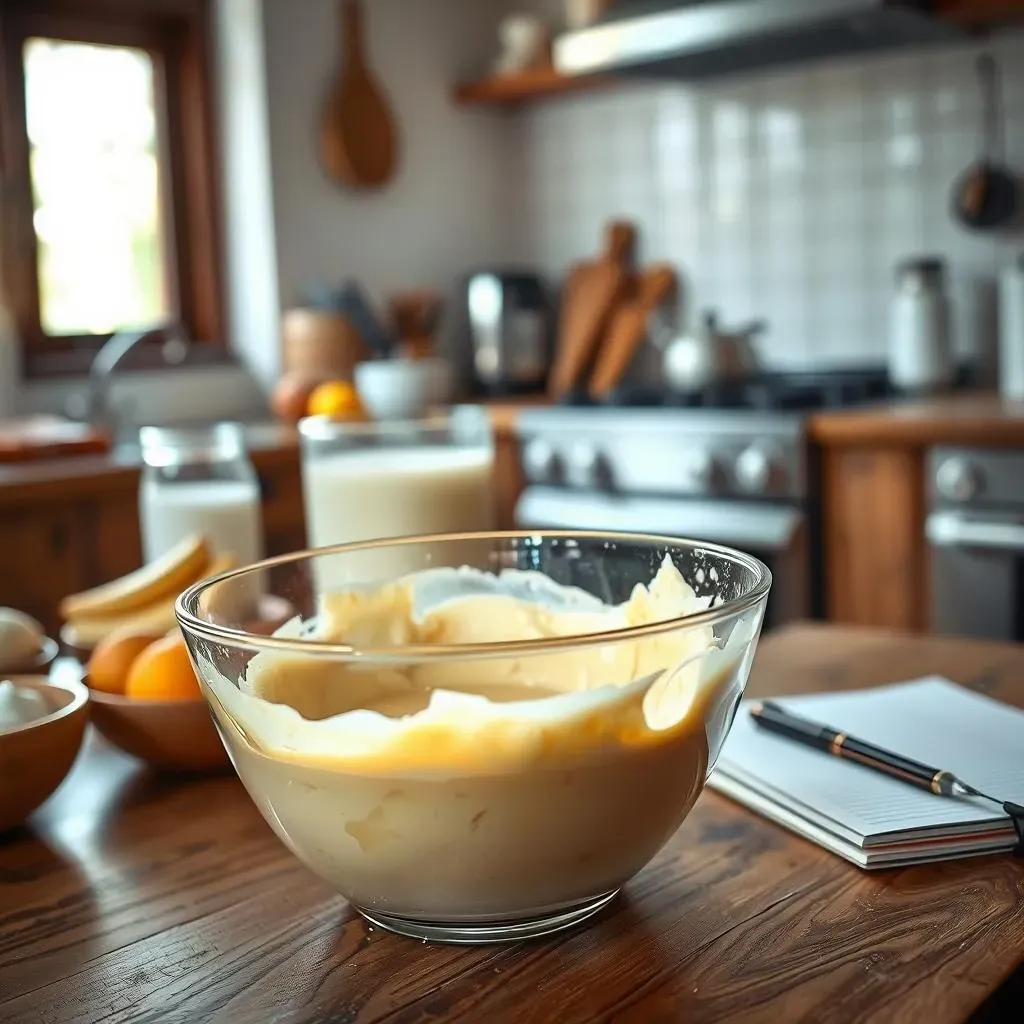Table of Contents
Ever stood in your kitchen, pancake mix in hand, wondering, "does pancake mix require milk?" You're not alone! It's a question that's plagued many a sleepy-eyed breakfast enthusiast. The truth is, while milk can add richness and flavor, it’s not always a must-have. This article is your guide to navigating the great milk-or-water pancake debate. We'll explore the science behind using different liquids, how they affect your pancakes, and give you tips to achieve the perfect fluffy stack, regardless of your choice. We'll cover why liquids are crucial for pancake batter, the differences between milk and water, how to adjust your mix, and even ways to boost flavor if you skip the milk. So, whether you're out of milk or just curious, let's make some awesome pancakes together. Get ready to flip your way to breakfast bliss!
The Liquid in Your Pancake Mix: Milk or Water?

The Liquid in Your Pancake Mix: Milk or Water?
The Science of the Batter
so you've got your pancake mix. It's basically a bunch of dry stuff like flour, sugar, and maybe some baking powder hanging out. To turn that into something edible, you need liquid. This liquid, whether it's milk or water, is what brings everything together. It activates the baking powder, which creates those air bubbles that make pancakes fluffy, and it allows the flour to form a batter. Without it, you'd just have a bowl of dry powder, and nobody wants that, right?
Think of it like this: the dry mix is the band, and the liquid is the glue that holds the whole performance together. It's what allows the ingredients to mingle and create something greater than the sum of their parts. The liquid is not just about getting the right consistency; it's about initiating the chemical reactions that transform the mix into a delicious, edible disk. The liquid is the unsung hero in the pancake world.
Liquid | Effect on Pancakes |
|---|---|
Milk | Adds richness, flavor, and a slightly denser texture. |
Water | Creates a lighter pancake, with a more neutral flavor. |
Milk vs. Water: The Showdown
So, milk versus water, it's the classic battle. Milk, with its fats and sugars, brings a richer flavor and a slightly denser texture to the party. It's like adding a little extra butter to your pancakes right from the start. If you're after that classic, comforting taste, milk is your go-to. But what if you're out of milk? Or maybe you prefer a lighter pancake? That's where water steps in.
Water is like the minimalist approach, it lets the other flavors in your mix shine through. Using water will often give you a lighter, fluffier pancake, and it's a great option if you're trying to cut back on calories or simply don't have milk on hand. Water might not bring the extra richness, but it gets the job done. It's the unsung hero for those times when you just want a good, basic pancake without any fuss. You can always add a knob of butter later for extra richness if you're really craving that flavor.
"The secret of great cooking is, first, having a love of it." - James Beard
Does Pancake Mix Require Milk? Exploring the Options

Does Pancake Mix Require Milk? Exploring the Options
The Standard Instructions vs. Reality
so you've probably glanced at the back of your pancake mix box. It usually says something like, "add milk, egg, and oil." But here's the thing: those are just suggestions, not strict rules. The mix is designed to work with those ingredients, sure, but it's not like your pancakes will explode if you dare to use water instead. The "milk" instruction is mostly about getting a certain flavor and richness, which many people prefer. But, it's good to know that you've got options, and it's not the end of the world if you're fresh out of milk. It's more about understanding the role the liquid plays in the batter and how to make it work for you.
The instructions are there to offer a convenient starting point. Think of them as a recipe's training wheels. Once you get the hang of it, you can start to experiment. The mix is just a combination of dry ingredients, and the liquid is what brings it to life. Whether it's milk, water, or even something else, it's all about what you are trying to achieve and what you have available. The key takeaway here is, don't be a slave to the instructions; be a master of your pancake destiny!
When Water is Your Best Friend
So, let's say you're out of milk, or maybe you're trying to make a vegan pancake. Water is your new best friend. It’s readily available and does the job of hydrating the dry ingredients just as well as milk. Water will give you a lighter, slightly less rich pancake, but that's not necessarily a bad thing. You can still get a great texture and a tasty result, and sometimes, you might even prefer the taste of a pancake made with water. It lets the flavor of the mix shine through without the extra richness of milk. Water is a great option for those who want a lighter, fluffier pancake.
Using water opens the door to all sorts of fun experiments, too. It gives you a blank canvas to add your own flavors. You can throw in a dash of vanilla extract, a pinch of cinnamon, or even some citrus zest to really make those pancakes sing. The key is to play around and see what you like best. Just because the box says milk doesn’t mean you can’t create something amazing with good old H2O. Remember, cooking is all about experimenting and making it your own.
Liquid | Flavor Impact | Texture Impact |
|---|---|---|
Milk | Richer, slightly sweeter | Denser, more substantial |
Water | Neutral, allows other flavors to shine | Lighter, fluffier |
Achieving Perfect Pancakes: Tips and Tricks Beyond Milk

Achieving Perfect Pancakes: Tips and Tricks Beyond Milk
Adjusting Liquid Measurements
so you've decided to ditch the milk and go with water, or maybe you're using a milk alternative. That's great! But here's the thing: you might need to tweak the amount of liquid you're using. The standard 1:1 ratio of liquid to mix is a good starting point, but it's not always the magic number. Sometimes, you'll find your batter is too thick, and sometimes, it's too runny. Don't panic! It's all part of the pancake adventure. If your batter looks like thick mud, add a little more liquid, a tablespoon at a time, until it reaches the consistency of thick cream. If it's too thin, add a bit of the dry mix. It's like Goldilocks, you're looking for the 'just right' consistency.
The key is to not dump in a whole bunch of liquid or dry mix at once. Small adjustments are the name of the game. A tiny splash of water or a sprinkle of flour can make all the difference. It's about paying attention to your batter and making those tiny tweaks until you get it just right. Remember, pancake batter is a living thing, and it might need a little extra love and attention to reach its full potential. So don't be afraid to play around and experiment until you find the perfect consistency for your desired pancake texture. It's a journey, not a race!
Boosting Flavor with Water
Alright, so you've gone the water route, and your pancakes are looking pretty good, but maybe they're missing that extra oomph. Don't worry, it’s super easy to boost flavor, even without milk. You can add a splash of vanilla extract, a pinch of cinnamon, or even some lemon zest to the batter. These little additions can make a world of difference. You can also add extra melted butter to the mix to give it that rich, buttery flavor you might be missing from the milk. Think of your pancake batter as a blank canvas, ready for your own creative touches. It’s not just about the base mix, but the flavors you choose to add to make it your own.
Another cool trick is to use flavored water, like coconut water, or even a bit of brewed coffee for a mocha twist. The possibilities are endless. And don't forget the toppings! A drizzle of maple syrup, a dollop of whipped cream, or some fresh berries can turn a simple pancake into a gourmet breakfast. The key takeaway here is that you're not limited by the lack of milk. It's an opportunity to explore new flavors and get creative in the kitchen. So go ahead, and have some fun with it. You're the master of your pancake domain!
Flavor Booster | How to Use | Why it Works |
|---|---|---|
Vanilla Extract | Add a teaspoon to the batter. | Adds warmth and depth of flavor. |
Cinnamon | Add a pinch to the batter. | Provides a sweet and spicy kick. |
Lemon Zest | Add a teaspoon to the batter. | Adds a bright, citrusy note. |
Extra Butter | Melt and add to the batter. | Adds richness and flavor. |
Wrapping Up the Pancake Mix Mystery
So, does pancake mix require milk? The short answer is no, but the long answer is it depends on what you're aiming for. Milk certainly brings a richer taste and a softer texture, but water is a perfectly acceptable substitute, especially if you're in a pinch or looking for a lighter option. The key to great pancakes, whether you use milk or water, lies in understanding how liquids interact with your mix, and knowing how to adjust your recipe accordingly. Experiment with different ratios, flavor enhancers, and techniques, and you'll be flipping out fantastic pancakes every time. Don't be afraid to try new things and, most importantly, have fun with it!